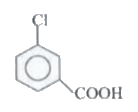In compounds of type ECl3, where E=B,P. As or Bi, the angles Cl−E−Cl for different E are in the order:
B>P=As=Bi
B>P>As>Bi
B<P=As=Bi
B<P<As<Bi
The correct Answer is:B
BCI3 is trigonal planar in structure and bond angles are 120∘ each. PCI3,AsCI3 and BiCI3 pyramidal in shape with sp3-hybridisation. In all of them, the bond angles are less than the normal tetrachedral angle of 109∘28', and also these bond angles decrese down the group. Therefore, the correct order of dond angles is as follows: BCI3>PCI3>AsCI3>BiCI3
Topper's Solved these Questions
- P-BLOCK GROUP 17 ELEMENTS - THE HALOGEN FAMILYBOOK - CENGAGE CHEMISTRY ENGLISHCHAPTER - P-BLOCK GROUP 17 ELEMENTS - THE HALOGEN FAMILYEXERCISE - Exercises Archives (Integer)
3 Videos
- P-BLOCK GROUP 17 ELEMENTS - THE HALOGEN FAMILYBOOK - CENGAGE CHEMISTRY ENGLISHCHAPTER - P-BLOCK GROUP 17 ELEMENTS - THE HALOGEN FAMILYEXERCISE - Exercises Archives (Fill In The Blanks)
1 Videos
- P-BLOCK GROUP 17 ELEMENTS - THE HALOGEN FAMILYBOOK - CENGAGE CHEMISTRY ENGLISHCHAPTER - P-BLOCK GROUP 17 ELEMENTS - THE HALOGEN FAMILYEXERCISE - Exercises Archives (Multiple Correct)
3 Videos
- P-BLOCK GROUP 16 ELEMENTS - THE OXYGEN FAMILYBOOK - CENGAGE CHEMISTRY ENGLISHCHAPTER - P-BLOCK GROUP 16 ELEMENTS - THE OXYGEN FAMILYEXERCISE - Archives Subjective
10 Videos
- P-BLOCK GROUP 18 ELEMENTS - THE INERT GASESBOOK - CENGAGE CHEMISTRY ENGLISHCHAPTER - P-BLOCK GROUP 18 ELEMENTS - THE INERT GASESEXERCISE - Ex 5.1 (Objective)
14 Videos
Similar Questions
Knowledge Check
Compound A (C7H7Cl) react with aq. KOH at room temperature and give compound D (C7H8O).Another isomer B gives only one mononitration product on treatment with HNO3+H2SO4 mixture. Isomer C give compound E (C7H5O2Cl) on heating with KMnO4 solution.E gives 3-chloro-4-nitrobenzoic acid as major product. Identify compound D.
A B
B C
C D
D
Statement-1 : If eiθ=cosθ+isinθ and the value of eiA.eiB.eiC is equal to -1, where A,B,C are the angles of a triangle.
and
Statement -2 : In any △ABC,A+B+C=180∘
View SolutionGiven below are a set of half-cell reactions (acidic medium) along with their E∘ with respect to normal hydrogen electrode values. Using the data obtain the correct explanation to question given below. I2+2e−→2I−E∘=0.54Cl2+2e−→2Cl−E∘=1.36Mn2++e−→Mn2+E∘=1.50Fe3++e−→Fe2+E∘=0.77O2+4H++4e−→2H2OE∘=1.23
While Fe2+ is stable, Mn3+ is not stable in acid solution because:
View SolutionGiven below are a set of half-cell reactions (acidic medium) along with their E∘ with respect to normal hydrogen electrode values. Using the data obtain the correct explanation to question given below. I2+2e−→2I−E∘=0.54Cl2+2e−→2Cl−E∘=1.36Mn2++e−→Mn2+E∘=1.50Fe3++e−→Fe2+E∘=0.77O2+4H++4e−→2H2OE∘=1.23
Among the following, identify the correct statement:
View SolutionHow many Cl atoms can you ionise in the process Cl→Cl++e, by the energy liberated for the process Cl+e→→Cl− for one Avogadro's number of atoms ? (Given : IP=13.0eV and EA=3.60eV) .
View SolutionA sample space consists of 9 elementary event E1,E2,E3.....E8,E9 whose probabilities are P(E1)=P(E2)=0.08 ,P(E3)=P(E4)=P(E5)=0.1, P(E6)=P(E7)=0.2 ,P(E8)=P(E9)=0.07. Suppose A={E1,E5,E8}, B={E2,E5,E8,E9}. Compute P(A), P(B) and P(A∩B). Using the addition law of probability, find P(A∪B). List the composition of the event A∪B, and calculate, P(A∪B) by adding the probabilities of the elementary events. Calculate P(¯¯¯B) from P(B), also calculate P(¯¯¯B) directly from the elementary events of ¯¯¯B.
View SolutionGiven :
Co3++e−→Co2+,E∘=+1.181V
Pb4++2e−→Pb2+,E∘=+1.67V
Ce4++e−→Ce3+,E∘=+1.61V
Bi3++3e−→Bi,E∘=+0.20V
Oxidizing power of the species will increase in the order:
View SolutionGiven :
Co3++e−→Co2+ , E∘=+1.81V
pb4++2e−→Pb2+ , E∘=+1.67V
Ce4+e−→Ce3+,E∘=+1.61V
Ce4+3e−→Bi, E∘=+0.20V
Oxidation power of the species will increase in the order:
View Solution
